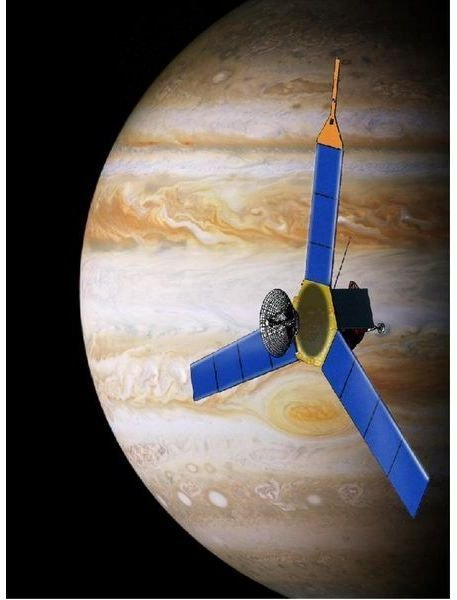Juno: New NASA Mission to Explore Jupiter
Juno is NASA’s newest planned mission to Jupiter. As part of the New Frontiers missions, it will focus on cost-effective research of the planetary giant. The project’s costs will not exceed USD $700 million, however, budgetary restrictions have caused the original launch date of June 2009 to be pushed back to August 2011. The orbiter will be launched aboard an Atlas V rocket, famously used for the Mars Reconnaissance Orbiter amongst many other satellites. Dr. Scott J. Bolton, from Southwest Research Institute in Texas, is in charge of the mission, working with the Jet Propulsion Laboratory in California. Lockheed Martin is building the spacecraft.
This will be the first time NASA has visited Jupiter since Galileo’s eight year study of the planet and its moons ended in 2003. Galileo used on-board instruments and a descent probe to relay information about the upper layer of Jupiter’s atmosphere and map part of the magnetosphere. Previous flyby missions include Pioneer 10 and 11, Voyager 1 and 2, Ulysses, Cassini and New Horizons. Unlike previous missions, Juno will be solar powered, greatly increasing its lifespan potential.
Mission Overview
The trajectory of the spacecraft will take it from the Earth’s surface into deep space. There it will perform an orbital maneuver between July and October 2012. This maneuver will take Juno back towards Earth where it will execute a flyby in 2013 that will give it a gravity assist speed boost. This boost acts as a slingshot, launching the craft towards its target of Jupiter. The planned time of arrival for the spacecraft is October, 2016. Juno will then carry out an orbital insertion burn over the planet to place it in a polar orbit. The mission is planned to continue observing Jupiter for 32 orbits until 2018, however, NASA has stated that the craft will most likely continue functioning well after the end of the mission.
To the right: An artist’s vision of Juno at Jupiter. (Image credit: Bricktop at Wikimedia Commons under public domain. NASA material is not protected by copyright unless noted. https://en.wikipedia.org/wiki/File:Juno_space_probe.jpg)
Objectives
While a visit to Jupiter will reveal many new facts about the planet and its many moons, Juno has specific mission objectives it plans to accomplish. These goals were derived from the years of research conducted by other probes and the questions that arose from the studies.
Juno will determine the exact ratio of oxygen to hydrogen as well as estimate the core mass of the planet. This will help distinguish the formation of the gas giant in relation to the solar system by measuring the abundance of water in its atmosphere.
The spacecraft will precisely map both Jupiter’s magnetic field and its gravitational distribution of mass. This should determine how deep inside the atmosphere Jupiter’s magnetic field begins and how the interior structure is formulated. In addition to planetary knowledge, this study will help scientists understand the general physics of dynamo theory. It will help them assess what mechanism within a planet creates a magnetic field.
As general scientific study, Juno will also map the composition of the atmosphere, its structure, temperature and cloud opacity. It will also explore Jupiter’s polar magnetosphere and auroras.
To perform these experiments, Juno will be fitted with eight different instruments: an advanced camera, an ultraviolent imaging spectrograph, a radio and plasma wave sensor, a microwave radiometer, an infrared auroral mapper, an energetic particle detector, a stellar compass and an experiment to analyze auroral distribution.
